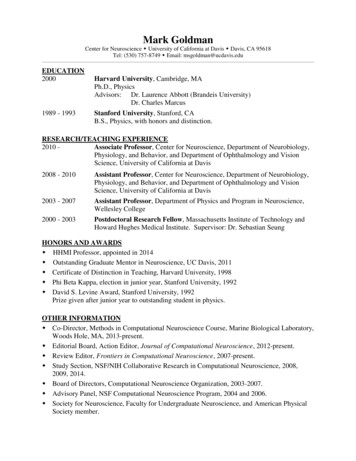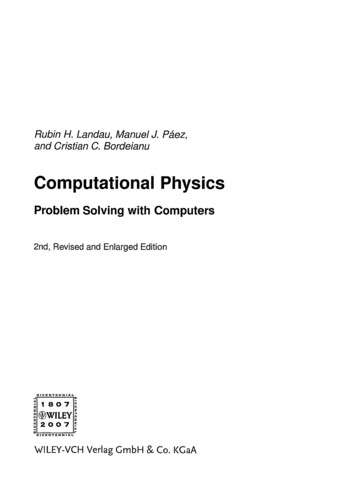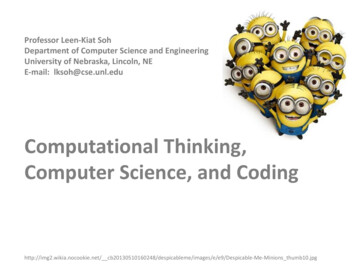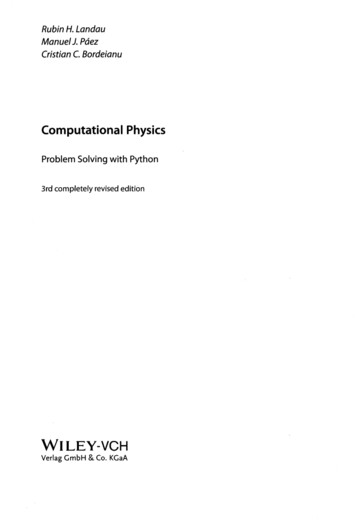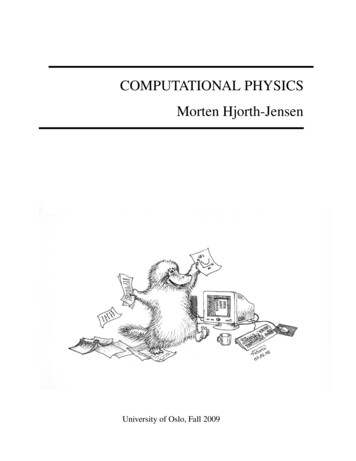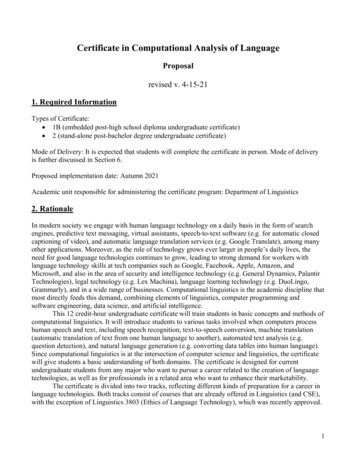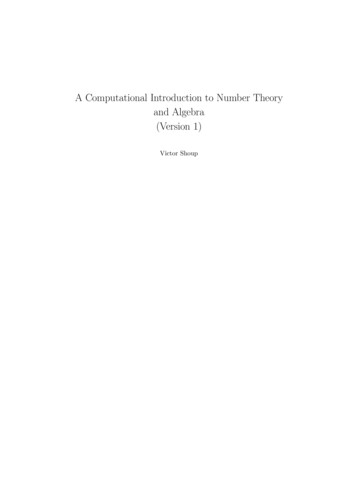
Transcription
A Computational Introduction to Number Theoryand Algebra(Version 1)Victor Shoup
This PDF document contains hyperlinks, and one may navigate through itby clicking on theorem, definition, lemma, equation, and page numbers, aswell as URLs, and chapter and section titles in the table of contents; mostPDF viewers should also display a list of “bookmarks” that allow directaccess to chapters and sections.
Copyright c 2005 by Victor Shoup victor@shoup.net All rights reserved. The right to publish or distribute this work in print formbelongs exclusively to Cambridge University Press; however, this electronicversion is distributed under the terms and conditions of a Creative Commonslicense (Attribution-NonCommercial-NoDerivs 2.0):You are free to copy, distribute, and display this electronicversion under the following conditions:Attribution. You must give the original author credit.Noncommercial. You may not use this electronic version forcommercial purposes.No Derivative Works. You may not alter, transform, orbuild upon this electronic version.For any reuse or distribution, you must make clear to othersthe license terms of this work.Any of these conditions can be waived if you get permissionfrom the author.For more information about the license, visitcreativecommons.org/licenses/by-nd-nc/2.0.
ContentsPrefacePreliminariespage xxiv1Basic properties of the integers1.1 Divisibility and primality1.2 Ideals and greatest common divisors1.3 Some consequences of unique factorization11482Congruences2.1 Definitions and basic properties2.2 Solving linear congruences2.3 Residue classes2.4 Euler’s phi function2.5 Fermat’s little theorem2.6 Arithmetic functions and Möbius inversion131315202425283Computing with large integers3.1 Asymptotic notation3.2 Machine models and complexity theory3.3 Basic integer arithmetic3.4 Computing in Zn3.5 Faster integer arithmetic ( )3.6 Notes333336394851524Euclid’s algorithm4.1 The basic Euclidean algorithm4.2 The extended Euclidean algorithm4.3 Computing modular inverses and Chinese remaindering4.4 Speeding up algorithms via modular computation4.5 Rational reconstruction and applications4.6 Notes55555862636673v
viContents5The5.15.25.35.45.55.6distribution of primesChebyshev’s theorem on the density of primesBertrand’s postulateMertens’ theoremThe sieve of EratosthenesThe prime number theorem . . . and beyondNotes747478818586946Finite and discrete probability distributions6.1 Finite probability distributions: basic definitions6.2 Conditional probability and independence6.3 Random variables6.4 Expectation and variance6.5 Some useful bounds6.6 The birthday paradox6.7 Hash functions6.8 Statistical distance6.9 Measures of randomness and the leftover hash lemma ( )6.10 Discrete probability distributions6.11 ic algorithms7.1 Basic definitions7.2 Approximation of functions7.3 Flipping a coin until a head appears7.4 Generating a random number from a given interval7.5 Generating a random prime7.6 Generating a random non-increasing sequence7.7 Generating a random factored number7.8 The RSA cryptosystem7.9 Notes1481481551581591621671701741798Abelian groups8.1 Definitions, basic properties, and examples8.2 Subgroups8.3 Cosets and quotient groups8.4 Group homomorphisms and isomorphisms8.5 Cyclic groups8.6 The structure of finite abelian groups ( )1801801851901942022089Rings9.1 Definitions, basic properties, and examples9.2 Polynomial rings211211220
Contents9.39.4Ideals and quotient ringsRing homomorphisms and isomorphismsvii23123610Probabilistic primality testing10.1 Trial division10.2 The structure of Z n10.3 The Miller–Rabin test10.4 Generating random primes using the Miller–Rabin test10.5 Perfect power testing and prime power factoring10.6 Factoring and computing Euler’s phi function10.7 Notes24424424524725226126226611Finding generators and discrete logarithms in Z p11.1 Finding a generator for Z p11.2 Computing discrete logarithms Z p11.3 The Diffie–Hellman key establishment protocol11.4 Notes26826827027528112Quadratic residues and quadratic reciprocity12.1 Quadratic residues12.2 The Legendre symbol12.3 The Jacobi symbol12.4 Notes28328328528728913Computational problems related to quadratic residues13.1 Computing the Jacobi symbol13.2 Testing quadratic residuosity13.3 Computing modular square roots13.4 The quadratic residuosity assumption13.5 Notes29029029129229729814Modules and vector spaces14.1 Definitions, basic properties, and examples14.2 Submodules and quotient modules14.3 Module homomorphisms and isomorphisms14.4 Linear independence and bases14.5 Vector spaces and dimension29929930130330630915Matrices15.1 Basic definitions and properties15.2 Matrices and linear maps15.3 The inverse of a matrix15.4 Gaussian elimination15.5 Applications of Gaussian elimination316316320323324328
viiiContents15.6 Notes33416Subexponential-time discrete logarithms and factoring16.1 Smooth numbers16.2 An algorithm for discrete logarithms16.3 An algorithm for factoring integers16.4 Practical improvements16.5 Notes33633633734435235617More rings17.1 Algebras17.2 The field of fractions of an integral domain17.3 Unique factorization of polynomials17.4 Polynomial congruences17.5 Polynomial quotient algebras17.6 General properties of extension fields17.7 Formal power series and Laurent series17.8 Unique factorization domains ( )17.9 Notes35935936336637137437637838339718Polynomial arithmetic and applications18.1 Basic arithmetic18.2 Computing minimal polynomials in F [X]/(f ) (I)18.3 Euclid’s algorithm18.4 Computing modular inverses and Chinese remaindering18.5 Rational function reconstruction and applications18.6 Faster polynomial arithmetic ( )18.7 Notes39839840140240541041542119Linearly generated sequences and applications19.1 Basic definitions and properties19.2 Computing minimal polynomials: a special case19.3 Computing minimal polynomials: a more general case19.4 Solving sparse linear systems19.5 Computing minimal polynomials in F [X]/(f ) (II)19.6 The algebra of linear transformations ( )19.7 Notes42342342842943543844044720Finite fields20.1 Preliminaries20.2 The existence of finite fields20.3 The subfield structure and uniqueness of finite fields20.4 Conjugates, norms and traces448448450454456
Contents2122Algorithms for finite fields21.1 Testing and constructing irreducible polynomials21.2 Computing minimal polynomials in F [X]/(f ) (III)21.3 Factoring polynomials: the Cantor–Zassenhaus algorithm21.4 Factoring polynomials: Berlekamp’s algorithm21.5 Deterministic factorization algorithms ( )21.6 Faster square-free decomposition ( )21.7 NotesDeterministic primality testing22.1 The basic idea22.2 The algorithm and its analysis22.3 NotesAppendix: Some useful factsBibliographyIndex of 0501504510512
PrefaceNumber theory and algebra play an increasingly significant role in computing and communications, as evidenced by the striking applications of thesesubjects to such fields as cryptography and coding theory. My goal in writing this book was to provide an introduction to number theory and algebra,with an emphasis on algorithms and applications, that would be accessibleto a broad audience. In particular, I wanted to write a book that would beaccessible to typical students in computer science or mathematics who havea some amount of general mathematical experience, but without presumingtoo much specific mathematical knowledge.Prerequisites. The mathematical prerequisites are minimal: no particularmathematical concepts beyond what is taught in a typical undergraduatecalculus sequence are assumed.The computer science prerequisites are also quite minimal: it is assumedthat the reader is proficient in programming, and has had some exposureto the analysis of algorithms, essentially at the level of an undergraduatecourse on algorithms and data structures.Even though it is mathematically quite self contained, the text does presuppose that the reader is comfortable with mathematical formalism andhas some experience in reading and writing mathematical proofs. Readers may have gained such experience in computer science courses such asalgorithms, automata or complexity theory, or some type of “discrete mathematics for computer science students” course. They also may have gainedsuch experience in undergraduate mathematics courses, such as abstract orlinear algebra — these courses overlap with some of the material presentedhere, but even if the reader already has had some exposure to this material,it nevertheless may be convenient to have all of the relevant material easilyaccessible in one place, and moreover, the emphasis and perspective herex
Prefacexiwill no doubt be different than in a typical mathematics course on thesesubjects.Structure of the text. All of the mathematics required beyond basic calculus is developed “from scratch.” Moreover, the book generally alternatesbetween “theory” and “applications”: one or two chapters on a particularset of purely mathematical concepts are followed by one or two chapters onalgorithms and applications —the mathematics provides the theoretical underpinnings for the applications, while the applications both motivate andillustrate the mathematics. Of course, this dichotomy between theory andapplications is not perfectly maintained: the chapters that focus mainlyon applications include the development of some of the mathematics thatis specific to a particular application, and very occasionally, some of thechapters that focus mainly on mathematics include a discussion of relatedalgorithmic ideas as well.In developing the mathematics needed to discuss certain applications, Itried to strike a reasonable balance between, on the one hand, presentingthe absolute minimum required to understand and rigorously analyze theapplications, and on the other hand, presenting a full-blown developmentof the relevant mathematics. In striking this balance, I wanted to be fairlyeconomical and concise, while at the same time, I wanted to develop enoughof the theory so as to present a fairly well-rounded account, giving the readermore of a feeling for the mathematical “big picture.”The mathematical material covered includes the basics of number theory(including unique factorization, congruences, the distribution of primes, andquadratic reciprocity) and abstract algebra (including groups, rings, fields,and vector spaces). It also includes an introduction to discrete probabilitytheory— this material is needed to properly treat the topics of probabilisticalgorithms and cryptographic applications. The treatment of all these topicsis more or less standard, except that the text only deals with commutativestructures (i.e., abelian groups and commutative rings with unity) — this isall that is really needed for the purposes of this text, and the theory of thesestructures is much simpler and more transparent than that of more general,non-commutative structures.The choice of topics covered in this book was motivated primarily bytheir applicability to computing and communications, especially to the specific areas of cryptography and coding theory. For example, the book maybe useful for reference or self-study by readers who want to learn aboutcryptography. The book could also be used as a textbook in a graduate
xiiPrefaceor upper-division undergraduate course on (computational) number theoryand algebra, perhaps geared towards computer science students.Since this is an introductory textbook, and not an encyclopedic referencefor specialists, some topics simply could not be covered. One such topicwhose exclusion will undoubtedly be lamented by some is the theory oflattices, along with algorithms for and applications of lattice basis reduction.Another such topic is that of fast algorithms for integer and polynomialarithmetic — although some of the basic ideas of this topic are developed inthe exercises, the main body of the text deals only with classical, quadratictime algorithms for integer and polynomial arithmetic. As an introductorytext, some topics just had to go; moreover, there are more advanced textsthat cover these topics perfectly well, and these texts should be readilyaccessible to students who have mastered the material in this book.Note that while continued fractions are not discussed, the closely relatedproblem of “rational reconstruction” is covered, along with a number of interesting applications (which could also be solved using continued fractions).Using the text. Here are a few tips on using the text. There are a few sections that are marked with a “( ),” indicatingthat the material covered in that section is a bit technical, and is notneeded elsewhere. There are many examples in the text. These form an integral part ofthe text, and should not be skipped. There are a number of exercises in the text that serve to reinforce,as well as to develop important applications and generalizations of,the material presented in the text. In solving exercises, the reader isfree to use any previously stated results in the text, including thosein previous exercises. However, except where otherwise noted, anyresult in a section marked with a “( ),” or in §5.5, need not andshould not be used outside the section in which it appears. There is a very brief “Preliminaries” chapter, which fixes a bit ofnotation and recalls a few standard facts. This should be skimmedover by the reader. There is an appendix that contains a few useful facts; where such afact is used in the text, there is a reference such as “see §An,” whichrefers to the item labeled “An” in the appendix.Feedback. I welcome comments on the book (suggestions for improvement,error reports, etc.) from readers. Please send your comments tovictor@shoup.net.
PrefacexiiiThere is also web site where further material and information relating tothe book (including a list of errata and the latest electronic version of thebook) may be found:www.shoup.net/ntb.Acknowledgments. I would like to thank a number of people who volunteered their time and energy in reviewing one or more chapters: Siddhartha Annapureddy, John Black, Carl Bosley, Joshua Brody, Jan Camenisch, Ronald Cramer, Alex Dent, Nelly Fazio, Mark Giesbrecht, StuartHaber, Alfred Menezes, Antonio Nicolosi, Roberto Oliveira, and Louis Salvail. Thanks to their efforts, the “bug count” has been significantly reduced,and the readability of the text much improved. I am also grateful to theNational Science Foundation for their support provided under grant CCR0310297. Thanks to David Tranah and his colleagues at Cambridge University Press for their progressive attitudes regarding intellectual property andopen access.New York, January 2005Victor Shoup
PreliminariesWe establish here a few notational conventions used throughout the text.Arithmetic with We shall sometimes use the symbols “ ” and “ ” in simple arithmeticexpressions involving real numbers. The interpretation given to such expressions is the usual, natural one; for example, for all real numbers x, wehave x , x , x , , and( ) ( ) . Some such expressions have no sensible interpretation (e.g., ).Logarithms and exponentialsWe denote by log x the natural logarithm of x. The logarithm of x to thebase b is denoted logb x.We denote by ex the usual exponential function, where e 2.71828 is thebase of the natural logarithm. We may also write exp[x] instead of ex .Sets and relationsWe use the symbol to denote the empty set. For two sets A, B, we use thenotation A B to mean that A is a subset of B (with A possibly equal toB), and the notation A ( B to mean that A is a proper subset of B (i.e.,A B but A 6 B); further, A B denotes the union of A and B, A Bthe intersection of A and B, and A \ B the set of all elements of A that arenot in B.For sets S1 , . . . , Sn , we denote by S1 · · · Sn the Cartesian productxiv
Preliminariesxvof S1 , . . . , Sn , that is, the set of all n-tuples (a1 , . . . , an ), where ai Si fori 1, . . . , n.We use the notation S n to denote the Cartesian product of n copies ofa set S, and for x S, we denote by x n the element of S n consisting ofn copies of x. (We shall reserve the notation S n to denote the set of all nthpowers of S, assuming a multiplication operation on S is defined.)Two sets A and B are disjoint if A B . A collection {Ci } of sets iscalled pairwise disjoint if Ci Cj for all i, j with i 6 j.A partition of a set S is a pairwise disjoint collection of non-emptysubsets of S whose union is S. In other words, each element of S appearsin exactly one subset.A binary relation on a set S is a subset R of S S. Usually, one writesa b to mean that (a, b) R, where is some appropriate symbol, andrather than refer to the relation as R, one refers to it as .A binary relation on a set S is called an equivalence relation if forall x, y, z S, we have x x (reflexive property), x y implies y x (symmetric property), and x y and y z implies x z (transitive property).If is an equivalence relation on S, then for x S one defines the set[x] : {y S : x y}. Such a set [x] is an equivalence class. It followsfrom the definition of an equivalence relation that for all x, y S, we have x [x], and either [x] [y] or [x] [y].In particular, the collection of all distinct equivalence classes partitions theset S. For any x S, the set [x] is called the the equivalence classcontaining x, and x is called a representative of [x].FunctionsFor any function f from a set A into a set B, if A0 A, then f (A0 ) : {f (a) B : a A0 } is the image of A0 under f , and f (A) is simply referredto as the image of f ; if B 0 B, then f 1 (B 0 ) : {a A : f (a) B 0 } is thepre-image of B 0 under f .A function f : A B is called one-to-one or injective if f (a) f (b)implies a b. The function f is called onto or surjective if f (A) B.The function f is called bijective if it is both injective and surjective; inthis case, f is called a bijection. If f is bijective, then we may define the
xviPreliminariesinverse function f 1 : B A, where for b B, f 1 (b) is defined to bethe unique a A such that f (a) b.If f : A B and g : B C are functions, we denote by g f theircomposition, that is, the function that sends a A to g(f (a)) C. Functioncomposition is associative; that is, for functions f : A B, g : B C,and h : C D, we have (h g) f h (g f ). Thus, we can simplywrite h g f without any ambiguity. More generally, if we have functionsfi : Ai Ai 1 for i 1, . . . , n, where n 2, then we may write theircomposition as fn · · · f1 without any ambiguity. As a special case of this,if Ai A and fi f for i 1, . . . , n, then we may write fn · · · f1 asf n . It is understood that f 1 f , and that f 0 is the identity function on A.If f is a bijection, then so is f n for any non-negative integer n, the inversefunction of f n being (f 1 )n , which one may simply write as f n .Binary operationsA binary operation ? on a set S is a function from S S to S, where thevalue of the function at (a, b) S S is denoted a ? b.A binary operation ? on S is called associative if for all a, b, c S, wehave (a ? b) ? c a ? (b ? c). In this case, we can simply write a ? b ? c withoutany ambiguity. More generally, for a1 , . . . , an S, where n 2, we canwrite a1 ? · · · ? an without any ambiguity.A binary operation ? on S is called commutative if for all a, b S,we have a ? b b ? a. If the binary operation ? is both associative andcommutative, then not only is the expression a1 ? · · · ? an unambiguous, butits value remains unchanged even if we re-order the ai .
1Basic properties of the integersThis chapter discusses some of the basic properties of the integers, includingthe notions of divisibility and primality, unique factorization into primes,greatest common divisors, and least common multiples.1.1 Divisibility and primalityConsider the integers Z : {. . . , 2, 1, 0, 1, 2, . . .}. For a, b Z, we saythat b divides a, or alternatively, that a is divisible by b, if there existsc Z such that a bc. If b divides a, then b is called a divisor of a, andwe write b a. If b does not divide a, then we write b - a.We first state some simple facts:Theorem 1.1. For all a, b, c Z, we have(i) a a, 1 a, and a 0;(ii) 0 a if and only if a 0;(iii) a b and a c implies a (b c);(iv) a b implies a b;(v) a b and b c implies a c.Proof. These properties can be easily derived from the definition using elementary facts about the integers. For example, a a because we can writea a · 1; 1 a because we can write a 1 · a; a 0 because we can write0 a·0. We leave it as an easy exercise for the reader to verify the remainingproperties. 2Another simple but useful fact is the following:Theorem 1.2. For all a, b Z, we have a b and b a if and only if a b.1
2Basic properties of the integersProof. Clearly, if a b, then a b and b a. So let us assume that a b andb a, and prove that a b. If either of a or b are zero, then part (ii) of theprevious theorem implies that the other is zero. So assume that neither iszero. Now, b a implies a bc for some c Z. Likewise, a b implies b adfor some d Z. From this, we obtain b ad bcd, and canceling b fromboth sides of the equation b bcd, we obtain 1 cd. The only possibilityis that either c d 1, in which case a b, or c d 1, in which casea b. 2Any integer n is trivially divisible by 1 and n. We say that an integerp is prime if p 1 and the only divisors of p are the trivial divisors 1and p. Conversely, an integer n is called composite if n 1 and it isnot prime. So an integer n 1 is composite if and only if n ab for someintegers a, b with 1 a n and 1 b n. The first few primes are2, 3, 5, 7, 11, 13, 17, . . . .The number 1 is not considered to be either prime or composite. Also, wedo not consider the negative of a prime (e.g., 2) to be prime (although onecan, and some authors do so).A basic fact is that any non-zero integer can be expressed as a signedproduct of primes in an essentially unique way. More precisely:Theorem 1.3 (Fundamental theorem of arithmetic). Every non-zerointeger n can be expressed asn pe11 · · · perr ,where the pi are distinct primes and the ei are positive integers. Moreover,this expression is unique, up to a reordering of the primes.Note that if n 1 in the above theorem, then r 0, and the productof zero terms is interpreted (as usual) as 1.To prove this theorem, we may clearly assume that n is positive, sinceotherwise, we may multiply n by 1 and reduce to the case where n ispositive.The proof of the existence part of Theorem 1.3 is easy. This amountsto showing that every positive integer n can be expressed as a product(possibly empty) of primes. We may prove this by induction on n. If n 1,the statement is true, as n is the product of zero primes. Now let n 1,and assume that every positive integer smaller than n can be expressed asa product of primes. If n is a prime, then the statement is true, as n is the
1.1 Divisibility and primality3product of one prime; otherwise, n is composite, and so there exist a, b Zwith 1 a n, 1 b n, and n ab; by the induction hypothesis, both aand b can be expressed as a product of primes, and so the same holds for n.The uniqueness part of Theorem 1.3 is by no means obvious, and mostof the rest of this section and the next section are devoted to developing aproof of this. We give a quite leisurely proof, introducing a number of othervery important tools and concepts along the way that will be useful later.An essential ingredient in this proof is the following:Theorem 1.4 (Division with remainder property). For a, b Z withb 0, there exist unique q, r Z such that a bq r and 0 r b.Proof. Consider the set S of non-negative integers of the form a zb withz Z. This set is clearly non-empty, and so contains a minimum. Let r bethe smallest integer in this set, with r a qb for q Z. By definition,we have r 0. Also, we must have r b, since otherwise, we would have0 r b r and r b a (q 1)b S, contradicting the minimality ofr.That proves the existence of r and q. For uniqueness, suppose that a bq r and a bq 0 r0 , where 0 r b and 0 r0 b. Then subtractingthese two equations and rearranging terms, we obtainr0 r b(q q 0 ).(1.1)Now observe that by assumption, the left-hand side of (1.1) is less than b inabsolute value. However, if q 6 q 0 , then the right-hand side of (1.1) wouldbe at least b in absolute value; therefore, we must have q q 0 . But then by(1.1), we must have r r0 . 2In the above theorem, it is easy to see that q ba/bc, where for any realnumber x, bxc denotes the greatest integer less than or equal to x. We shallwrite r a mod b; that is, a mod b denotes the remainder in dividing a byb. It is clear that b a if and only if a mod b 0.One can generalize the notation a mod b to all integers a and b, with b 6 0:we define a mod b : a bq, where q ba/bc.In addition to the “floor” function b·c, the “ceiling” function d·e is alsouseful: for any real number x, dxe is defined as the smallest integer greaterthan or equal to x.Exercise 1.1. Let n be a composite integer. Show that there exists a primep dividing n, such that p n 1/2 .
4Basic properties of the integersExercise 1.2. For integer n and real x, show that n x if and only ifn bxc.Exercise 1.3. For real x and positive integer n, show that bbxc/nc bx/nc.In particular, for positive integers a, b, c, bba/bc/cc ba/(bc)c.Exercise 1.4. For real x, show that 2bxc b2xc 2bxc 1.Exercise 1.5. For positive integers m and n, show that the number ofmultiples of m among 1, 2, . . . , n is bn/mc. More generally, for integer m 1and real x 0, show that the number of multiples of m in the interval [1, x]is bx/mc.Exercise 1.6. For integers a, b with b 0, show that b a mod b 0.1.2 Ideals and greatest common divisorsTo carry on with the proof of Theorem 1.3, we introduce the notion of anideal of Z, which is a non-empty set of integers that is closed under addition,and under multiplication by an arbitrary integer. That is, a non-empty setI Z is an ideal if and only if for all a, b I and all z Z, we havea b I and az I.Note that for an ideal I, if a I, then so is a, since a a · ( 1) I.It is easy to see that any ideal must contain 0: since an ideal I must containsome element a, and by the closure properties of ideals, we must have 0 a ( a) I. It is clear that {0} and Z are ideals. Moreover, an ideal I isequal to Z if and only if 1 I — to see this, note that 1 I implies thatfor all z Z, z 1 · z I, and hence I Z; conversely, if I Z, then inparticular, 1 I.For a Z, define aZ : {az : z Z}; that is, aZ is the set of all integermultiples of a. It is easy to see that aZ is an ideal: for az, az 0 aZ andz 00 Z, we have az az 0 a(z z 0 ) aZ and (az)z 00 a(zz 00 ) aZ. Theset aZ is called the ideal generated by a, and any ideal of the form aZfor some a Z is called a principal ideal.We observe that for all a, b Z, we have a bZ if and only if b a.We also observe that for any ideal I, we have a I if and only if aZ I.Both of these observations are simple consequences of the definitions, as thereader may verify. Combining these two observations, we see that aZ bZif and only if b a.We can generalize the above method of constructing ideals.For
1.2 Ideals and greatest common divisors5a1 , . . . , ak Z, definea1 Z · · · ak Z : {a1 z1 · · · ak zk : z1 , . . . , zk Z}.That is, a1 Z · · · ak Z consists of all linear combinations, with integercoefficients, of a1 , . . . , ak . We leave it to the reader to verify that a1 Z · · · ak Z is an ideal and contains a1 , . . . , ak ; it is called the ideal generated bya1 , . . . , ak . In fact, this ideal is the “smallest” ideal containing a1 , . . . , ak , inthe sense that any other ideal that contains a1 , . . . , ak must already containthis ideal (verify).Example 1.1. Let a : 3 and consider the ideal aZ. This consists of allinteger multiples of 3; that is, aZ {. . . , 9, 6, 3, 0, 3, 6, 9, . . .}. 2Example 1.2. Let a1 : 3 and a2 : 5, and consider the ideal a1 Z a2 Z.This ideal contains 2a1 a2 1. Since it contains 1, it contains all integers;that is, a1 Z a2 Z Z. 2Example 1.3. Let a1 : 4 and a2 : 6, and consider the ideal a1 Z a2 Z.This ideal contains a2 a1 2, and therefore, it contains all even integers.It does not contain any odd integers, since the sum of two even integers isagain even. 2The following theorem says that all ideals of Z are principal.Theorem 1.5. For any ideal I Z, there exists a unique non-negativeinteger d such that I dZ.Proof. We first prove the existence part of the theorem. If I {0}, thend 0 does the job, so let us assume that I 6 {0}. Since I contains non-zerointegers, it must contain positive integers, since if z I then so is z. Letd be the smallest positive integer in I. We want to show that I dZ.We first show that I dZ. To this end, let c be any element in I. Itsuffices to show that d c. Using the division with remainder property, writec qd r, where 0 r d. Then by the closure properties of ideals, onesees that r c qd is also an element of I, and by the minimality of thechoice of d, we must have r 0. Thus, d c.We next show that dZ I. This follows immediately from the fact thatd I and the closure properties of ideals.That proves the existence part of the theorem. As for uniqueness, notethat if dZ d0 Z, we have d d0 and d0 d, from which it follows byTheorem 1.2 that d0 d. 2For a, b Z, we call d Z a common divisor of a an
Number theory and algebra play an increasingly significant role in comput-ing and communications, as evidenced by the striking applications of these subjects to such fields as cryptography and coding theory. My goal in writ-ing this book was to provide an introduction to number theory and algebra,
